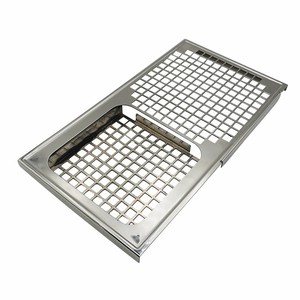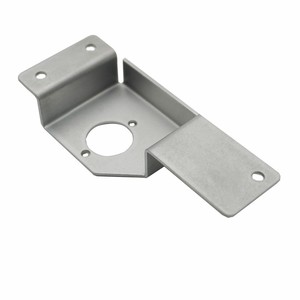
All categories
Featured selections
Trade Assurance
Buyer Central
Help Center
Get the app
Become a supplier

(3338 products available)




















Market Overview: The market for MIM (Metal Injection Molding) parts has experienced robust growth, fueled by the increasing demand for lightweight and complex components across various industries. According to Research and Markets, the global motor vehicle parts market, which includes MIM parts, is projected to grow from $2,771.76 billion in 2023 to $2,985.68 billion in 2024, reflecting a compound annual growth rate (CAGR) of 7.7%. This growth is driven by rapid urbanization and the rising production of motor vehicles, which has intensified the need for high-performance components. As electric vehicle (EV) adoption rises, the MIM parts segment is expected to adapt to evolving manufacturing requirements, with vehicles featuring fewer moving parts, thus reshaping the supply chain dynamics.
Industry Insights: The shift towards electric vehicles is a significant driver for the MIM parts market, as manufacturers seek to develop components that meet the unique demands of EV designs. The transition to electric vehicles necessitates innovations in MIM technology, particularly to produce lightweight components that enhance vehicle efficiency. As the automotive industry emphasizes technological advancements, the integration of artificial intelligence and 3D printing techniques in MIM processes is gaining traction. Furthermore, major players in the market are focusing on strategic partnerships to expand distribution channels and enhance product offerings. This trend indicates a promising outlook for MIM parts, as manufacturers align their strategies towards sustainability and efficiency, meeting the evolving needs of consumers and the automotive sector.
MIM parts are formed by mixing fine powders of metal and plastic, resulting in complex geometries for obsolete or unfeasible forms. They can be separated based on their application.
Materials
The appropriate materials are needed in MIM to make MIM parts. Certain qualities have to be met to make the MIM process viable, like plasticity and strength. Usually, metal powder like stainless steel is used for the core, surrounded by a solid and flowable polymer.
Temperature
The MIM process needs precise heat levels at various stages, like the debinding and sintering processes. During sintering, the temperature has to rise above 1,200°C for titanium powder to weld the particles together.
Design Complexity
Even geometric details are complicated, but the design of MIM parts is still simple. Parts with increased accuracy and slenderness can be made through MIM. Internal cavities and walls as thin as 1 mm can be present in designs.
Pressure
According to specification, an injection molding machine with a holding force of 28 tons is required to make MIM parts of this size. A different machine with a 210-ton clamping force is needed for MIM parts of this size, and it holds the mold with higher pressure.
To maintain the MIM parts properly and ensure their longevity, it is essential to clean the parts regularly cleaning them with a soft cloth. It's also necessary to keep the parts away from harmful chemicals that could damage them. Storing them in a dry environment will also help maintain them. Further, temperature fluctuations should be avoided, and they shouldn't be exposed to extreme heat or cold that could cause warping. If any parts require lubrication, it is critical to lubricate moving components with high-quality oil or grease. Finally, routine inspections should be carried out to check for any signs of wear or damage and address any issues as soon as possible.
Medical industry:
The medical industry demands high-precision components. MIM parts are prevalent in the field. MIM technology makes drugs adjustable for patients, enhancing medication personalization and improving patient outcomes. MIM assists in creating intricate, lightweight drug delivery devices that possess both reliability and efficiency. MIM is utilized to manufacture components for minimally invasive surgical instruments, such as endoscopic forceps. Furthermore, MIM can manufacture disposable medical equipment, like syringes and connectors, in large quantities. The production process is fast, fulfilling the need for speed in the medical industry.
Automative industry:
MIM parts are used in automotive applications. Luxury and performance vehicles often include automobiles that require high-performance components. These components must be robust enough to withstand harsh conditions and lightweight to enhance fuel efficiency. MIM technology is also used to manufacture intricate, lightweight automotive accessories such as knobs and handles. In addition, automobiles require many parts, including gear shafts, connectors, locks, and even lightweight aluminum parts, all of which can be made using MIM technology.
Aerospace industry:
The aerospace industry needs light but strong materials and products. MIM technology can create lightweight and complex engine parts. The nozzles, valves, and actuator components of spacecraft are also made using MIM technology. Another usage is aerospace fasteners.
Choosing metal injection molding parts requires careful consideration of various factors.
Specify parts requirements
To begin with, it is essential to determine the performance needs of the components. Things like strength, endurance, temperature resistance, magnetism, conductivity, hardness, and other functional requirements must be identified.
Secondly, the geometry of the parts should be confirmed, comprising the size, weight, and complexity of the structure. Besides, it's important to ascertain the quantity of parts that need to be produced. MIM is especially cost-effective for large production volumes, typically in the thousands or tens of thousands.
Moreover, the materials for MIM should be researched as well. MIM offers a wide range of materials, including stainless steel, tool steel, carbon steel, low-expansion steel, high-temperature alloys, nickel alloys, copper alloys, etc. Each material has its unique properties and suitability for specific applications.
Finally, the budget constraints for the project should be considered. While MIM offers cost-effective solutions for large-scale production, it is essential to evaluate the cost implications based on materials, design complexity, and production volume.
Find suitable MIM suppliers
Buyers can search for suppliers who provide MIM services in bulk on platforms like Alibaba.com. When browsing MIM suppliers, remember to check the suppliers' company profile, approvals, product testing, and certification. Contact the suppliers and ask about their product-related certifications to ensure the product's quality.
Furthermore, consider the suppliers' production capacity, technical proficiency, and experience in dealing with specific industries or applications. Strong partnerships can be forged by picking suppliers who meet specific requirements and expectations.
Q: What metals can be used for MIM parts?
A: The MIM process has been shown to work with a variety of metals, allowing for the creation of MIM metal parts from diverse metal compounds. Commonly utilized metals encompass stainless steel, low-alloy steel, tool steel, carbon steel, copper, brass, bronze, nickel, titanium, zirconium, tungsten, and molybdenum. Besides these, an entire range of metal mixtures can be employed, encompassing uncommon earth elements, to meet particular demands for MIM metal component applications.
Q: What is the maximum size limitation for MIM parts?
A: Typical parts made by MIM usually weigh less than 100 grams and are less than 300 millimeters in size. Nevertheless, depending on the material and design, some large MIM parts can weigh up to one kilogram and measure up to 500 millimeters.
Q: Can MIM be used for high-volume production?
A: Yes, one of the significant advantages of MIM is its cost-effectiveness for high-volume production. Once the tooling is created, parts can be produced at a rapid rate with consistent quality.
Q: Are there design limitations for MIM parts?
A: While MIM can create complex shapes, there are some design limitations. Features should be drafted, and undercuts and thin walls are limited. Working with experienced designers is essential to ensure that the designs are suitable for MIM manufacturing.